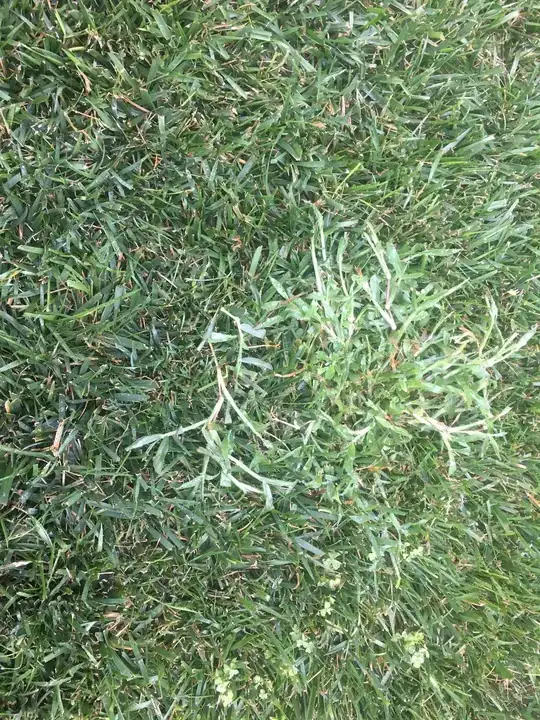This is crab crass. Dig this up if you are able.
Another way to deal with this quackgrass is to don plastic gloves, a bit of glyphosate, and using a skirt for protection of drips simply wipe glyphosate on a few of the leaves of that weed grass. Do not spray, just wipe. Wait for 3 weeks. If there's any live growth left, simply do it again.
If your lawn is very very infested with this grass, let us see if just getting you on a proper maintenance program for cool season grasses (fescue mix) will cure your problem long term, instead of spot-treating the infestation:
1. Mowing
Your problem right now is you are mowing way way way too short. You need to make absolutely sure that mower deck is raised to cut no shorter than 3". It would be even better to do 3 1/2". Cool season grasses need that amount of top growth to feed their genetically mandated massive root systems. Plants make their own food. Without that photosynthetic top growth and enough chlorophyll factories, your grass crop is weakened, wimpy and weeds will move in!
You also need to sharpen your blades. The torn edges at the top of your blades of grass tell me your blades are dull. This will make your lawn dusty-looking as well as invite disease.
The other beauty is that height of grass shades the soil (minimizing evaporation) as well as not allowing seeds of weeds to germinate.
2. Watering
Water only when you step on your lawn and are able to see your footprints stay down. Do not water any other time. Weeds have shallow roots, your grasses have large, deep roots that are able to access moisture 6" down. Weeds will not be able to germinate nor will they be able to thrive in between waterings when you allow the surface to dry out. Very simple, easy peasy and works! Then you water and water deeply!
This trains your grass crop to have deeper roots, and when your neighbors have brown lawns (very bad thing to do) you will have a thick, dark green luscious lawn that you only water 1" per week. Saves water in a huge way. And protects your investment in your grass crop!
After watering check the depth of moisture in your lawn bed with a shovel. You want at least 4" to 6" deep moisturized soil. This training of your grass will have to be done in steps. There is also a thing you can do using a kitty cat food can or tuna fish can to see how much water you are applying during whatever time you've set; 15 minutes? If those cans (placed all over your lawn) collect 1/4" in say 15 minutes, that means you need to water for an hour to get 1" of water. 1" per week is your goal. Watering every 3 days is not bad but you want to get to a once weekly watering if possible. If your soil is sloped or over dry this is not a good thing to do right away.
3. Other actvities
Aerate once per year by pulling plugs of soil and lawn out of your lawn and allowing those plugs to disintegrate where they fall.
Fertilize at least 4X per season. Use season specific formulations (do not use high nitrogen for the fall application or too much new growth=fungus). I use Dr. Earth's Lawn Fertilizer. I don't receive anything for saying this, I'm just always blown away with the results. It's more expensive initially but you'll need only 2 to 3 applications, not 4. It adds beneficial fungus and thatch-eating bacteria as well, and a few micro chemicals. Healthy grasses can best defeat disease and weeds!
Test the pH of your lawn bed. 6.5 to 7.2 is great. Any lower and you need to lime. You should ask a follow-up question, if the results are outside that range.

